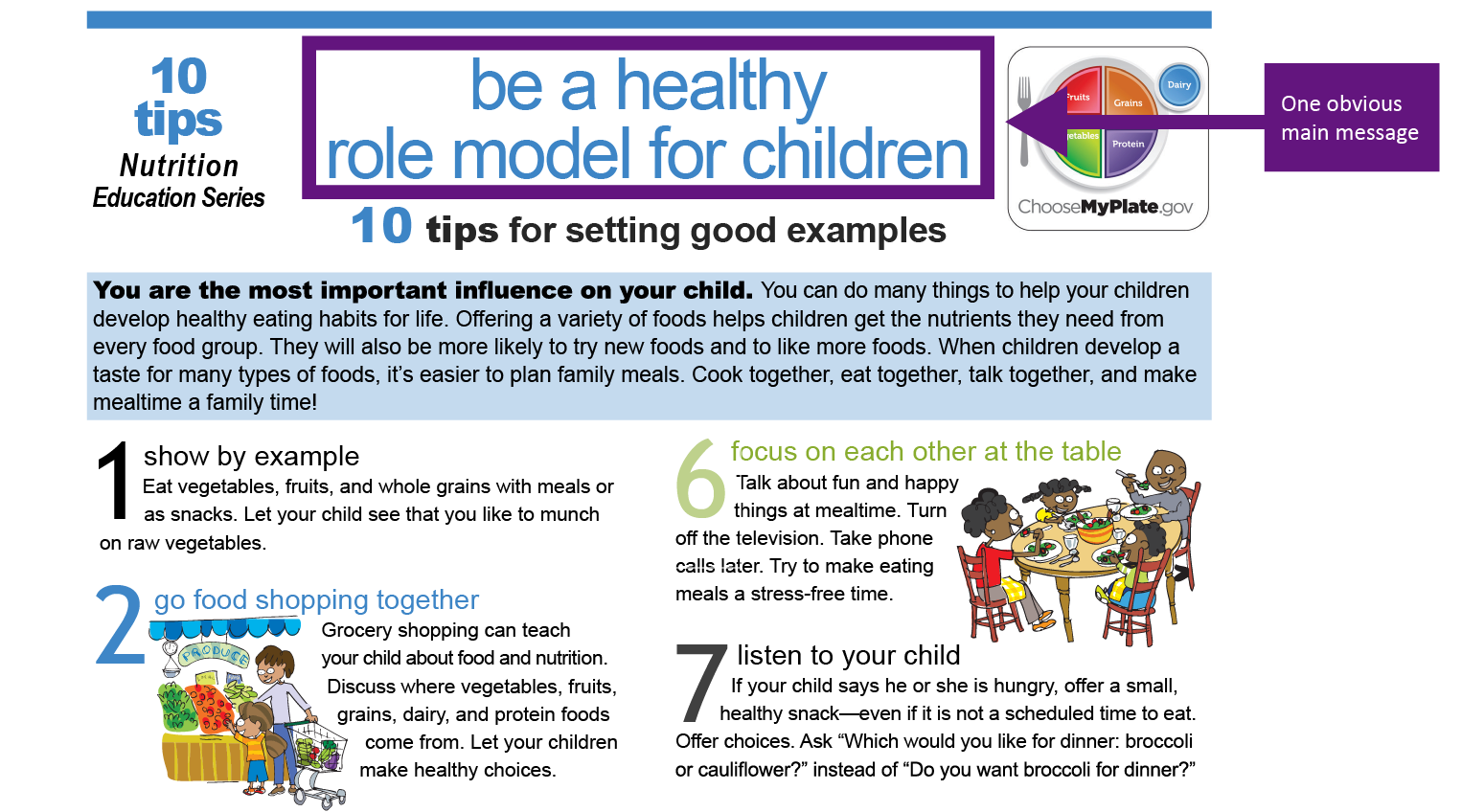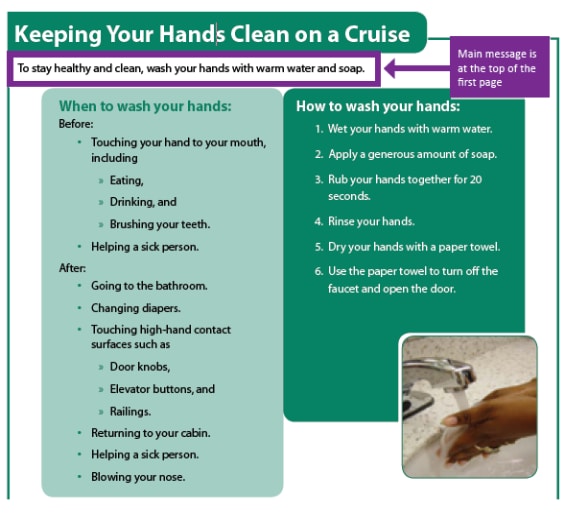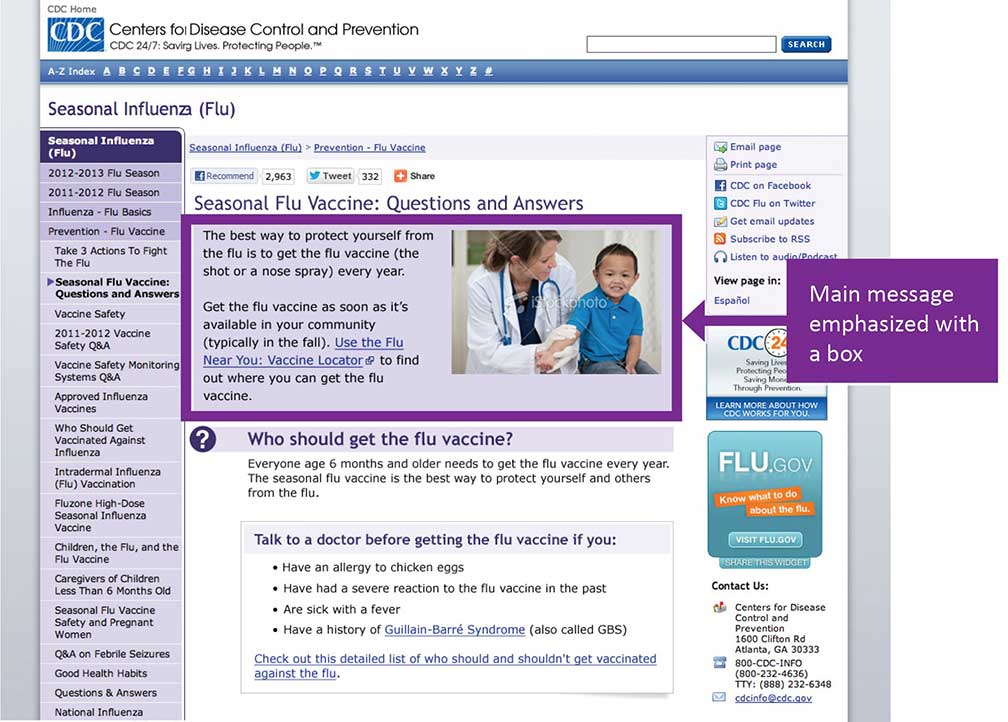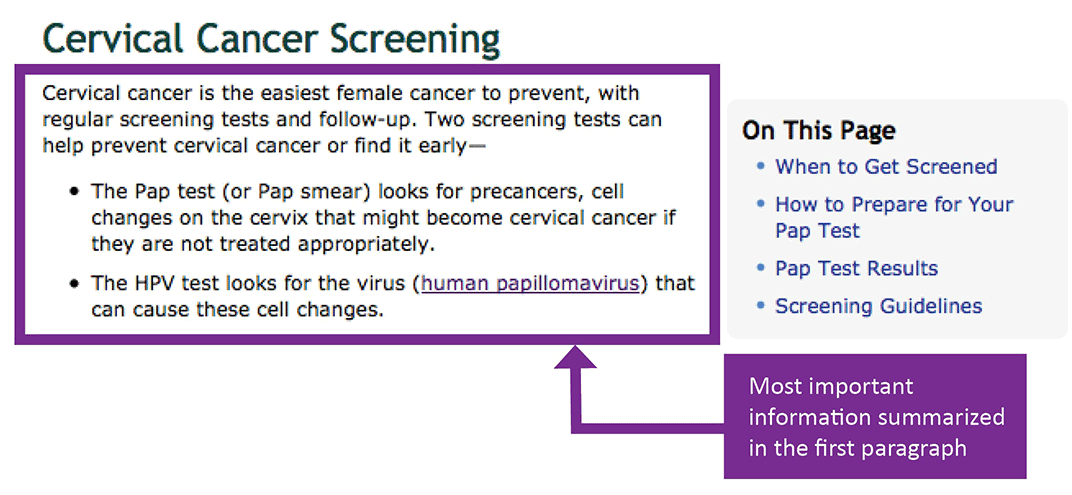*For Print and Web materials only
Tips
Make sure the material has one obvious main message. The main message should
reflect the purpose and most important information in the material.
You can combine the main message statement and the call to action (what you want people to do after receiving and understanding the main message), or they can be separate sentences.
Example

*For Print and Web materials only
Tips
People look for the most important information at the top, beginning, or front of a material. When you put the main message first, people can find it more easily and quickly.
Example

Supporting Plain Language Guideline: Identify and write for your audience.
Supporting Plain Language Guideline: Organize to meet your readers’ needs.
Tips
People perceive differences in size, shape, and color as meaningful. When you use visual cues to draw attention to the main message, people will more easily and quickly recognize it.
Examples of visual cues are:
- Boldface
- Color
- Shapes
- Lines and arrows
- Font type, size, alignment, and spacing
- Heading, such as “What you need to know”
To make visual cues compatible with web accessibility guidelines, include descriptive alternative text, such as “The main message is...,” for the screen reader.
Example

Tips
Photographs, line drawings, graphs, and infographics are visuals. When they are clearly designed and not overloaded with information, they can help people easily and quickly grasp information. Make sure the words and visuals in the material convey the same message and reinforce each other.
Government rules about information accessibility on the web mean that all visuals need
to have labels and captions. Labels and captions will help audiences easily and
quickly get the gist of a visual and reduce chances of misinterpretation.
Example

Supported by the CDC Style Guide: A visual can convey ideas in a way words cannot.
*For Print and Web materials only
Tips
Tell the primary audience what you want them do with the information you've given
them. Even when your purpose is to inform an audience, think about why they need
this information, and use this insight to create a call to action.
Example
If you have questions about your relationship, call 1-800-XXX-XXX. If you are in danger right now, call 911. Find out more about getting help.
*For Print and Web materials only
Tips
Use the active voice and allow the subject of the sentence to perform the action.
Active voice is used most often in conversation.
Example
Active Voice: Wash fruits and vegetables before you cut or peel them.
Passive Voice: Fruits and vegetables should be washed before they are cut or peeled.
Supporting Plain Language Guideline: Use active voice.
Supported by the CDC Style Guide: As a rule, use the active voice because it is more accurate, direct, precise, and interesting.
*For Print and Web materials only
Tips
Choose words the primary audience uses every day to help them process information more easily and quickly. Be careful, though, not to use slang, colloquial, metaphorical, or offensive language.
When you need to use an unfamiliar term, explain it where you use it — in the same sentence or immediately after.
The general rule is to use acronyms and abbreviations sparingly, and when you do use them, spell them out and explain what they refer to. If people don’t need to know the full word or phrase, use alternative phrasing.
Pilot testing the material can tell you if you have used the language that will resonate with the primary audience.
Example
The best way to prevent cervical cancer is to get regular Pap tests. A Pap test, sometimes called a Pap smear, is a screening test for cervical cancer. It's done in a doctor's office or clinic. While you lie on the exam table, the doctor or nurse will put a medical tool, called a speculum, into your vagina, opening it to see your cervix. The cervix connects the uterus, or womb, to the vagina.
Supporting Plain Language Guideline: Use short, simple words.
Supporting Plain Language Guideline: Minimize abbreviations.
Example
Use lists to break up text in the body of the material and make information easier to scan and read. Lists with more than 7 items must be broken into sub-lists.
Before:
There are many factors that put you at risk for developing type 2 diabetes. Being
overweight or obese is one of the major risk factors. Having a parent, brother, or sister with diabetes is also a risk factor. If you are African American, American Indian, Asian American, Pacific Islander, or Hispanic/Latino American you may be at greater risk.
After:
Am I at risk for diabetes? You may be at risk for type 2 diabetes if you:
- Are overweight or obese
- Have a parent, brother, or sister with diabetes
- Are African American, American Indian, Asian American, Pacific Islander, or Hispanic/Latino American
Supporting Plain Language Guideline: Use lists.
Tips
Break text into chunks to help the audience remember and group similar information. Chunked
information also looks less dense and overwhelming to read.
Use headings to organize and label chunks. Headings must accurately reflect the information that follows, or they can distract or confuse the audience. Headings are visually distinct (in font style, size, and with spacing) from the body text of the document. Make sure to leave more space above a heading than below.
Example
Gear up.
If your child is active in sports, make sure he uses the right protective gear for his activity, like a helmet, wrist guards, or knee or elbow pads.
Use the right stuff.
Be sure that protective sports gear is in good condition and worn correctly at all times. For example, avoid missing or broken buckles or worn-out padding.
Practice makes perfect.
Have your child learn and practice the skills she needs for her activity. For example, if she plays
football, knowing how to tackle safely is important in preventing injuries. Be sure to safely and
slowly increase your child's activities so she can improve her physical fitness. This can protect your
child from getting hurt.
Supporting Plain Language Guideline: Write short sections.
Supporting Plain Language Guideline: Write short paragraphs.
*For Print and Web materials only
Tips
Present information so that the amount doesn't overwhelm the audience. You don't need to provide all the information you have in one material. Instead, include only the most important information for the main message you've selected. You can provide the audience ways to get additional or related information if they want it.
Examples of types of information that may be important include:
- Basics I need to know (Understanding)
- I would like to learn more (Assessment)
- I can do this (Overcoming Barriers)
- How will this help me? (Motivators)
- Ways I can take action (Strategies)
- Where can I go for help? (Community Resources)
Example

Supporting Plain Language Guideline: Organize to meet your readers’ needs.
Tips
Acknowledge uncertainty about data, findings, recommendations, guidance and action steps. What we know today may not be fully accurate or sufficient to answer all of the public’s questions.
Acknowledging uncertainty introduces the idea that CDC findings and recommendations may change over time.
Example
Some medicines are known to be harmful to pregnant women. Many medicines have not been tested on pregnant women — so doctors are not sure if they are safe or not. If you are pregnant or planning on getting pregnant:
- Write down what medicines you take
- Keep track of how much medicine you take
- Ask your doctor if it is safe for you to take your medicine during pregnancy
More examples are available.
*For Print and Web materials only
Tips
Tell people upfront what they can do to protect and promote their health. Behavioral recommendations are specific actions people can take to protect their health or the health of others. When you create health or safety messages, focus on behavior rather than medical facts or statistics.
Example
If you are pregnant, getting a flu shot is the best way to protect yourself from the flu. Here are some other steps you can take to keep yourself and your family healthy this flu season:
- Make sure everyone 6 months of age and older gets the flu shot or nasal spray
- Wash your hands often to prevent the spread of germs.
If you have been near someone with the flu, talk to your doctor about taking medicine, called antiviral medicine. Antiviral medicine can prevent you from getting sick.
*For Print and Web materials only
Tips
Give the primary audience reasons why they should or shouldn’t do health behaviors and tell them possible consequences of doing or not doing the behaviors.
Example
If you are a woman age 65 or older, schedule a bone density test. A bone density test measures how strong your bones are. The test will tell you if you are at risk for osteoporosis.
Osteoporosis is a disease of the bones. It means your bones are weak and more likely to break. There are no signs or symptoms of osteoporosis. You might not know you have the disease until you break a bone. That’s why it’s so important to get a bone density test to measure your bone strength.
Tips
In addition to recommending behaviors, be sure to tell the audience how to do the behaviors. Be as specific as possible about how often or how long a behavior needs to be performed.
Breaking behavior down into specific action steps can increase people’s confidence in their ability to perform the behavior, known as self-efficacy, which is an important predictor of health behavior.
Example
- Wet your hands with clean running water and lather with soap.
- Rub your hands together for at least 30 seconds.
- Rinse your hands with clean running water.
*For Print and Web materials only
Tips
Express numbers in common terms. Most people find it challenging to make meaning from percentages, decimals, fractions and other numbers commonly used in research. For example, many people have difficulty with very large and very small numbers and measurement units such as milligrams.
During formative research, always ask audience members about their understanding of numbers used in the material. If you don't have formative research findings, use numbers most often used by non-experts, such as whole numbers.
Note: There are some instances in which decimals are commonly used, such as human body temperature (98.6 degrees).
Example
Before:
Eighty-one percent of children ages 6 months to 6 years watch TV or videos for about 1.96 hours a day.
After:
8 out of 10 children ages 6 months to 6 years watch TV or videos for about 2 hours a day.
Tips
Avoid using qualitative descriptors, such as high and low or large and small, by themselves. When you use qualitative descriptors, you must also provide the number and explain the meaning.
Example
The amount of meat recommended as part of a healthy meal is 3 to 4 ounces — it will look about the same size as a deck of cards.
*For Print and Web materials only
Tips
Be sure to do the math rather than expect the audience to calculate. Provide calculations and conversions so that the audience isn’t distracted, confused or intimidated by the numbers and formulas or misinformed by errors in their calculations.
Example
How much money did you spend on alcohol last year?
If you had 3 alcoholic drinks a day and each drink cost $4, then you spent $4,380 last year on alcoholic drinks. What else could you do with $4,380 this year?
*For Print and Web materials only
Tips
Tell audiences what the actual threat or harm is and how they will be affected. State the cause and effect connection between the risk and the effects of being at risk.
Provide enough information so that audiences can evaluate what the risk means to them and how they might be affected. For example:
- What will happen if they don’t take the recommended actions or perform behaviors to protect or promote their health?
- Will they experience a minor, temporary inconvenience or a life-changing event with long-term effects?
Example
Raw milk can carry harmful bacteria and other germs that can make you very sick or kill you if you drink it.
Getting sick from drinking raw milk can mean many days of diarrhea, stomach cramping, and vomiting. Less commonly, it can mean kidney failure, paralysis, chronic disorders, and even death.
*For Print and Web materials only
Tips
Recognize that non-expert audiences may perceive risks and benefits differently than public health or clinical professionals or statisticians. To make informed decisions, people need to understand the risks (perceived and actual) and benefits (perceived and actual) of behaviors, treatments, and preventive measures.
Example
You may feel like smoking helps you relax and reduces stress. But smoking hurts you and the people in your life. In fact, smoking harms nearly every organ in your body.
*For Print and Web materials only
Tips
People better understand probabilities when they are presented with words and visuals that match and reinforce the meaning of the numbers than when numbers are presented alone.
Example
Foodborne illness, sometimes called food poisoning, is common. Each year, about 1 in 6 Americans (or 48 million people) gets sick.

Supported by the CDC Style Guide: Visuals are often the most effective way to display large sets of numbers or data.
About the CDC CCI Widget
Each Index item has a numerical score of zero or one. The individual scores are converted to an overall score on a scale of 100. The Index provides a score so that developers of communication products can objectively assess and improve materials based on the best available science.
To score a material using the Index, you will:
- Answer 4 intro questions to identify your primary audience, their health literacy skills, your communication objective, and the main message.
- Score the Core section (Part A). This section has 11 questions and applies to all materials.
- Score the Behavior section (Part B). This section has 3 questions and may not apply to all materials.
- Score the Numbers section (Part C). This section has 3 questions and may not apply to all materials.
- Score the Risk Section (Part D). This section has 3 questions and may not apply to all materials.
Add notes about how you score each Index item so you can refer to them later or share them with your colleagues.
Not familiar with the Index or need a refresher? Check out the FAQs page.
Prefer using the Index on paper? Print out the Index Score Sheet This score sheet is for materials one page or longer. Examples include fact sheets, brochures, web pages, and reports.
Looking for more explanations and examples of the 20 items? Visit the User Guide





